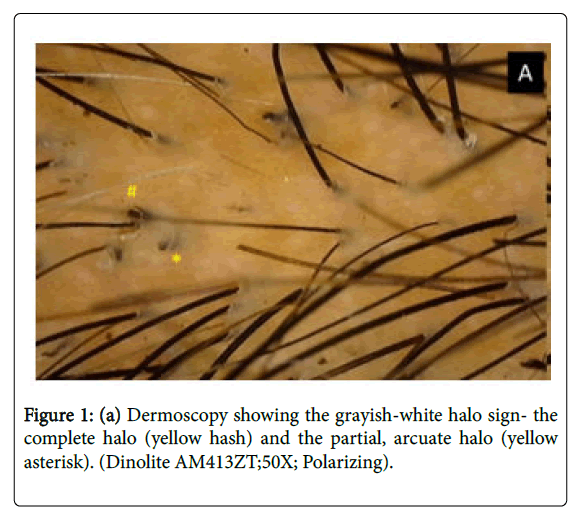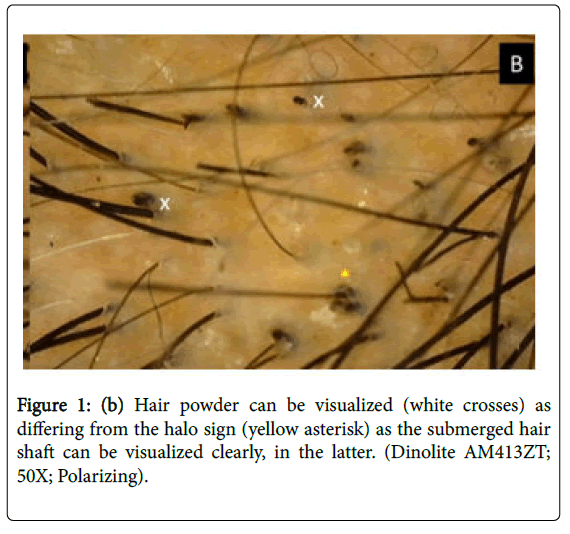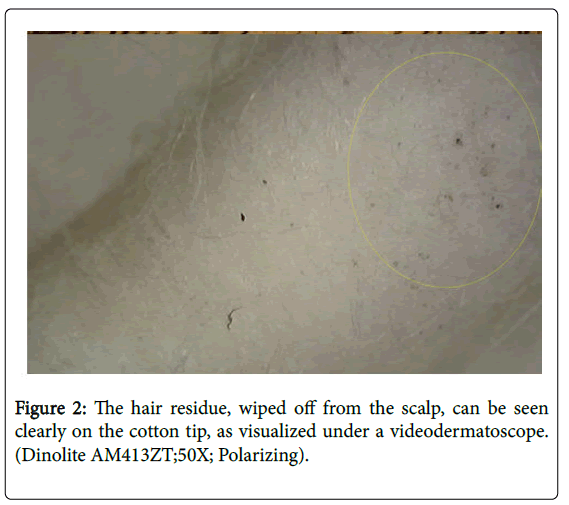Hair Therapy & Transplantation
Open Access
ISSN: 2167-0951
ISSN: 2167-0951
Editorial - (2019)Volume 9, Issue 1
Trichoscopy has come up, in a big way, and is routinely being employed in nearly all hair consultations. This non-invasive modality can be used as a diagnostic modality, as well as to monitor therapy. When it comes to patchy alopecia, alopecia areata, trichotillomania and tinea capitis are the most common differential diagnoses. Black dots, common to all the aforementioned, is commonly mistaken with hair dust (powder), the latter being specific to trichotillomania. On epilumescense microscopy of the scalp, a black dot is seen as a complete or arcuate greyish-white halo around the black dot, which occurs due to the proximal submerged part of the hair shaft, that refracts polarized light. We propose this as the ‘halo’ sign. Whereas, in the case of hair dust, it is a complete disintegration of decapitated hair, which is seen as a speck of powder, that can be removed easily with a cotton bud/Q-tip. This sign is proposed as the ‘wipe-out sign’. This report reiterates that trichoscopy is a quick, non-invasive diagnostic aid that can help delineate specific signs in trichology, to sort out common differentials, with newer signs being added, to this dynamic field.
Trichoscopy has emerged, almost as a diagnostic necessity, and has grown steadily with advances in trichology. Both black dots (cadaverized hair) and hair powder are trichoscopic features of trichotillomania, as well as alopecia areata. The black dots are due to remnant of the upper part of the hair root, which remains adherent to the hair-follicle ostium. Hair powder, also known as hair dust, on the other hand, is caused by complete destruction of the hair shaft, leaving a ‘sprinkled hair residue’ [1]. It is often difficult to differentiate between these structures, as they tend to look similar, especially at lower resolutions and magnifications [2]. We propose the ‘halo sign’ to differentiate between these two features.
A complete or arcuate greyish-white halo around the black dots is appreciable on trichoscopic examination which is due to the proximal submerged part of the hair shaft that refracts polarized light through the epidermis (Figure 1a). This halo is not seen in hair powder, which is a complete disintegration of decapitated hair (Figure 1b). Additionally, hair powder can be wiped out with the help of a cotton bud, as they are a result of fragmentation of intact hair, whereas the same does not hold true for hair dust (Figure 2). This sign, we propose as the ‘wipe-out sign’. Both these signs have been tabulated, for ready reference (Table 1). This report reiterates that trichoscopy is a quick, non-invasive diagnostic aid that can help delineate specific signs in trichology.

Figure 1a: Dermoscopy showing the grayish-white halo sign- the complete halo (yellow hash) and the partial, arcuate halo (yellow asterisk). (Dinolite AM413ZT;50X; Polarizing).

Figure 1b: Hair powder can be visualized (white crosses) as differing from the halo sign (yellow asterisk) as the submerged hair shaft can be visualized clearly, in the latter. (Dinolite AM413ZT; 50X; Polarizing).

Figure 2: The hair residue, wiped off from the scalp, can be seen clearly on the cotton tip, as visualized under a videodermatoscope. (Dinolite AM413ZT;50X; Polarizing).
Table 1: Summary tabulation of the newly proposed, distinguishing signs between black dots and hair dust (powder).
| Black dot | Hair dust | |
| Halo sign | Present | Absent |
| Wipe-out sign | Absent | Present |
Table 1: Summary tabulation of the newly proposed, distinguishing signs between black dots and hair dust (powder).
Citation: Agrawal S, Dhurat R, Sharma A (2019) Two New Signs- ‘Halo Sign’ and ‘Wipeout Sign’ to Differentiate Black Dots from Hair Dust on Trichoscopy. Hair Ther Transplant 9:e111. doi: 10.35248/2167-0951.19.9.e111
Received: 09-Apr-2019 Accepted: 15-Apr-2019 Published: 22-Apr-2019 , DOI: 10.35248/2167-0951.19.9.e111
Copyright: © 2019 Agrawal S, et al. This is an open-access article distributed under the terms of the Creative Commons Attribution License, which permits unrestricted use, distribution, and reproduction in any medium, provided the original author and source are credited.